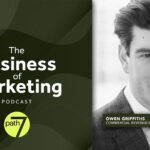By Matthew Don, COO, Doremus+Co.
B2B marketing is enjoying a surge of attention and increased budgets: B2B spending is expected to reach $70 billion in major markets by the end of 2026. Still, there is still an unwillingness by many B2B marketers to invest in long-term brand-building efforts. At the same time, much of the messaging out there feels trivial and unlikely to bolster interest in companies and their offerings beyond the moment. To realize their growth ambitions, B2B marketers need to be planting seeds for future success, rather than just boosting short-term sales.
B2B marketers are not unusual in feeling pressure to deliver short-term results. Everyone in business wants to “make their year.” But branding is a marathon, not a sprint, and the typical, cyclical spend-then-cut mindset too often leads to nonstrategic campaigns that work against successful long-term brand-building.
Not long ago an RFP was circulating that reflected a routine—and damaging—misunderstanding about branding: A B2B company, clearly in turmoil, wanted to establish its brand in a “bold” way that would rally stakeholders for years to come. The challenge? The company was looking for its third CMO in as many years and needed to build its corporate marketing staff while dealing with the departure of its CEO and founder. The silver bullet it sought was the creation of “one brand everyone can get behind.” But irrespective of a new positioning, a new identify, a new tagline, or any other new brand asset, it didn’t have the team, the culture, or the mindset to follow through with the kind of organized, enduring effort that links a brand to growth and gain.
There is a better way. It requires not just creativity and an integrated brand experience—those are table stakes—but organizational stability. The best B2B brands display a consistency (internally and in the marketplace) that drives their success. An emotive brand perception isn’t enough—it’s the principles driving the brand that create an enduring success. I call this unifying approach “Brand to Bottomline” marketing, and it’s guided by “The Five O’s:”
Originality: A solid brand must have a unique value proposition and brand personality that resonates with its audience. It requires distinctiveness and differentiation while infusing creativity into its brand messaging and awareness. Storytelling should be used to create a memorable and emotionally charged connection that is directly relevant to the value proposition of the company.
Here’s a great example of bull’s-eye originality: the Workday campaign featured famous musicians Ozzy Osbourne, Joan Jett, and others griping about corporate types being called “rock stars.” Workday’s tools are so effective at making rock stars out of their HR and finance clients that real rock stars resent it—an unforgettable way to elevate the value of “boring” business services.
Orchestration: This means coordinating a consistent, integrated brand experience across all stakeholder touchpoints (especially the customer and prospect) and aligning the entire organization towards delivering a compelling and “total” brand experience—online and offline, across omnichannel touchpoints.
Adobe has done this well within its cloud and marketing strategy. The ecosystem of creative connected products unifies every aspect of content, creativity, and campaigns in a way that is relatable to the end user and is supported by an integrated approach to customer experience and marketing.
When the message is consistent across all campaigns, and integrated throughout all targeting, acquisition, and fulfillment efforts, a brand can take root and grow.
Optimization: Companies should implement measurement tools to assess the brand’s impact. Brand and performance marketing, working together, should be tested and tweaked to deliver greater impact across campaigns, driving short- and long-term objectives. Underpinning this measurement is the understanding of audience behaviors, their buying journeys, and critically, a customer’s lifecycle revenue.
Salesforce offers a powerful example of this concept with its State of Marketing report. By compiling insights from thousands of marketing leaders and making those insights available to the public, Salesforce positions itself not simply as a suite of customer-relationship management software but as an active research partner guiding clients toward healthy strategies. Its analysis is beneficial internally—and sharing that analysis with others underscores and reinforces the company’s core value proposition.
Organization: A strong brand culture that reflects an organization’s values and purpose is critical. Good branding is never just about a clever ad campaign, it’s also about fostering a brand-aligned culture throughout a business and connecting organizational activities to the brand purpose.
San Francisco-based software company Autodesk nails this. The company serves architecture, engineering, and manufacturing clients, among others, and has built a culture around green buildings and sustainability. The mission of the company attracts and retains like-minded talent, as evidenced by the firm’s high Glassdoor ranking, and is reflected in the product lines that help clients model enviro-friendly facilities. Autodesk CSR initiatives are matched to the industries they serve. A customer’s increasing urgency for environmental health needs a partner that shows up with purpose, not just positioning.
This is what happens when brand mission is an operational reality from the C-suite down to entry-level. Messaging is simply icing.
Operations: This is culture in action, culture as daily routine. In a technical sense it includes such things as optimizing the marketing ecosystem with technology tools, but in a broader sense, it’s about aligning the brand across its operating principles and processes. It ensures that brand strategies, initiatives, and activities are aligned with overarching business behaviors.
IBM does a good job aligning commercial goals to brand—the two seem bound to one another. Through its strong alignment of partners with emerging in-house capabilities, IBM is strengthening its legacy while making a case for how essential it is to the world. Its “Let’s Create” brand initiative offers a compelling, aspirational message—and also reflects what the company is actually doing and how it operates at a basic level.
Increased B2B spend is a positive development, but it isn’t enough to drive brand to the bottom line. To do that and to fully realize a marketing mandate, money needs to be well spent, not merely spent.






